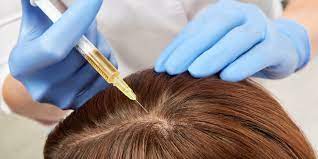Platelet-rich plasma (PRP) hair treatment is gaining significant popularity in Dubai as a non-surgical solution for hair restoration. This procedure utilizes the body's growth factors to stimulate hair follicles and promote new hair growth. If you're considering prp treatment dubai, it's essential to understand the procedure thoroughly. This article delves into what happens during a PRP hair treatment session, from preparation to post-treatment care.
Understanding PRP Hair Treatment
PRP hair treatment involves using a concentration of platelets derived from the patient's own blood. Platelets are rich in growth factors that can stimulate hair follicles, improve blood circulation, and enhance the natural healing process. The treatment is minimally invasive, offering an alternative to traditional hair restoration methods like hair transplants.
Initial Consultation and Assessment
Before the actual PRP hair treatment, you'll undergo an initial consultation with a qualified dermatologist or hair restoration specialist in Dubai. This consultation is crucial for determining your suitability for the procedure. The doctor will assess your hair loss pattern, discuss your medical history, and perform some tests to evaluate your overall health and the health of your scalp.
During this consultation, the specialist will also set realistic expectations about the results of the treatment. They will explain the procedure, potential risks, and the number of sessions required for optimal results.
Preparation for the Procedure
On the day of the treatment, the first step involves preparing your blood sample. A nurse or technician will draw a small amount of blood from your arm, similar to a routine blood test. The blood is then placed in a centrifuge, a machine that spins the blood at high speeds to separate its components. This process isolates the platelet-rich plasma from other blood components like red blood cells and white blood cells.
Scalp Preparation
Once the PRP is prepared, the next step is to prepare the scalp for the injection. Your scalp will be cleansed thoroughly to remove any oils or residues. In some cases, a local anesthetic may be applied to numb the treatment area and minimize discomfort. The anesthetic can be in the form of a topical cream or injections.
PRP Injection Process
With the scalp numb, the PRP is injected into specific areas of the scalp where hair thinning or loss is evident. The injections are administered using a fine needle, and the number of injections depends on the size of the treatment area and the degree of hair loss.
The PRP is injected into the dermis, the layer of skin beneath the surface, where it interacts with the hair follicles. The growth factors in the PRP stimulate the follicles, potentially promoting new hair growth and improving the overall health of existing hair.
Post-Treatment Care
After the PRP injections, the treatment area may be slightly tender, and you might experience mild swelling or redness. These effects are temporary and usually subside within a few days. Your dermatologist will provide specific aftercare instructions to ensure optimal results. Common recommendations include:
Avoiding Washing:
Refrain from washing your hair for at least 24 to 48 hours after the procedure to allow the PRP to fully integrate into the scalp.
Avoiding Heat:
Avoid hot showers, saunas, and intense exercise for a few days to prevent excessive sweating and irritation.
No Hair Products:
Avoid using hair products like gels or sprays for a few days to prevent any potential irritation.
Follow-Up Sessions
PRP hair treatment typically requires a series of sessions for the best results. The number of sessions needed varies based on individual factors such as the extent of hair loss and the response to the treatment. Most patients undergo treatments every 4 to 6 weeks for the initial phase, followed by maintenance sessions every 4 to 6 months.
During follow-up visits, your dermatologist will assess the progress of the treatment and make any necessary adjustments. They may also recommend additional treatments or complementary therapies to enhance results.
Results and Expectations
PRP hair treatment does not provide instant results. It usually takes several months to notice visible improvements. Patients often begin to see new hair growth and improved hair density within 3 to 6 months of starting the treatment. The full benefits of PRP therapy can continue to develop over a year.
It's important to have realistic expectations about the results. While PRP can significantly improve hair thickness and density, it may not fully restore hair to its original state, especially in cases of advanced hair loss.
Benefits and Risks
PRP hair treatment offers several benefits, including:
Non-surgical:
PRP is a non-invasive treatment, reducing the need for more invasive procedures.
Minimal Downtime:
Recovery time is minimal, with most patients resuming their normal activities within a day or two.
Natural Approach:
Since PRP uses your blood, there is a lower risk of allergic reactions or adverse effects.
However, like any medical procedure, PRP hair treatment has potential risks, such as:
Temporary Discomfort:
Some patients may experience mild discomfort or soreness at the injection sites.
Results Variability:
Results can vary based on individual responses to the treatment.
Multiple Sessions Required:
Optimal results typically require multiple sessions, which can be time-consuming and costly.
Conclusion
PRP hair treatment is an innovative and promising option for those seeking a non-surgical solution to hair loss. By utilizing the body's natural growth factors, this procedure can stimulate hair follicles and promote hair growth. Understanding what happens during the procedure, from preparation to aftercare, can help you make informed decisions and set realistic expectations for your hair restoration journey in Dubai.






Comments